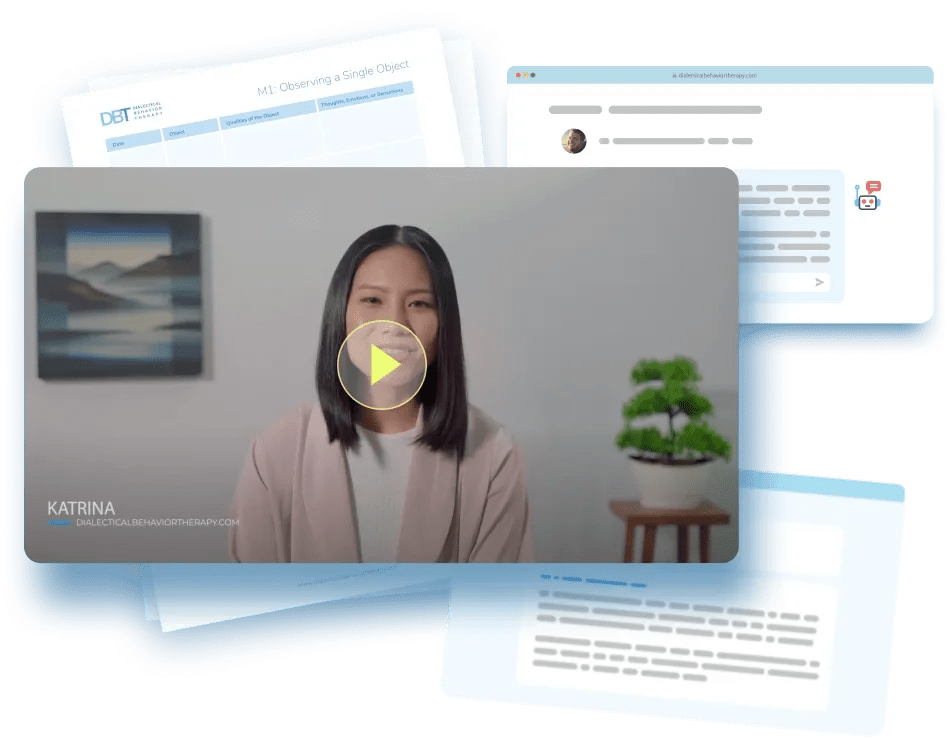Virtual Coach
Work step-by-step through the Interpersonal Effectiveness exercise with the virtual coach.
Introduction
Ever tried to say something important, but ended up damaging the relationship in the process? Or maybe you stay silent just to “keep the peace,” even though it leaves you feeling resentful?
The GIVE skill is your tool for communicating in a way that protects both the message and the relationship. It’s part of DBT’s interpersonal effectiveness skills, designed for situations where you want to ask for something, say no, or express yourself without pushing the other person away.
While DEAR MAN helps you be assertive, GIVE helps you be kind and connected. It’s about being effective and gentle, especially with people you care about.
You can use GIVE in friendships, romantic relationships, family conversations, or even in professional settings where warmth matters.
Let’s go over how it works.
What GIVE means
G – Be Gentle
I – Act Interested
V – Validate
E – Use an Easy manner
This skill helps you connect while still standing your ground. It’s especially useful when your goal is to maintain the relationship, not just win the argument.
How to do GIVE Skill
Step One: G – Be Gentle
Don’t attack, threaten, or blame. Keep your tone calm and your body language relaxed. Being gentle doesn’t mean being passive. It means not escalating things unnecessarily.
Avoid sarcasm, rolling your eyes, or shutting down. Don’t “dig for guilt” or use ultimatums.
Example: Instead of “You never help out around here,” try “It would really help if you could take care of the dishes tonight.”
If things get tense, take a breath before responding. Your calmness will set the tone.
Step Two: I – Act Interested
Even if you’re upset or disagreeing, show that you care about the other person’s point of view. This means listening, not interrupting, and making space for their perspective. Use open body language. Nod occasionally. Ask questions. Try to stay present instead of mentally preparing your rebuttal.
Example: “I hear you’re feeling stressed about work, that makes sense.”
This doesn’t mean you have to agree. It just means you’re showing basic respect.
Step Three: V – Validate
Acknowledge the other person’s feelings, even if you don’t like how they’re acting. Validation helps people feel seen and understood, which lowers defensiveness.
Validation sounds like: “I get why you’d feel that way.” or, “That must have been frustrating.” or, “I can see how that upset you.”
This step alone can soften a conversation dramatically.
Step Four: E – Use an Easy Manner
Stay approachable. Be warm if you can. Use humor (if it fits). Relax your face, your voice, and your posture. Even in tough conversations, small things like a soft tone or a slight smile can keep things human. You can also use casual language if it helps the message land better. Formal doesn’t always mean effective.
Example: Instead of “We need to have a serious talk,” try “Hey, can we chat for a second about something that’s been on my mind?”
This makes it easier for the other person to stay open.
Applying GIVE to Your Life
Situation: You want to ask your friend to stop canceling plans last minute.
Using GIVE:
G: “I’m not upset, and this isn’t an attack, just want to share how I’ve been feeling.”
I: “I know your schedule has been wild lately, and I want to understand.”
V: “It makes sense that you’ve been overwhelmed, it’s a lot to juggle.”
E: “Can we figure out a way to make our plans work better for both of us?”
This approach makes it easier for the other person to hear you without feeling defensive or shut down.
Worksheet & Virtual Coach
FAQs
Isn’t this just sugarcoating?
Nope. GIVE isn’t about hiding the truth. It’s about delivering it in a way that respects the relationship. You can still be direct and assertive, just not harsh or reactive.
What if the other person is being rude or aggressive?
You can still use GIVE to keep your cool, but that doesn’t mean you tolerate disrespect. If someone is mistreating you, you can combine GIVE with FAST or DEAR MAN to hold the line while staying calm.
What if I feel fake being “easy” or “gentle”?
That’s normal at first. You’re building a skill. Over time, using a calm tone and validating others will feel more natural, and you’ll get better results in your relationships.
Can I use GIVE in text messages or emails?
Yes. Just write in a tone that feels kind and clear. Avoid accusations, ALL CAPS, or sarcasm. Imagine the person reading your message with headphones in and a latte in hand. Keep the vibe human.
What if I lose my cool even when I try to use GIVE?
That happens. Use STOP first to ground yourself before the conversation starts. GIVE is easier when your nervous system isn’t in fight-or-flight mode.
How do I validate someone when I totally disagree with them?
Validation doesn’t mean agreement. Use Wise Mind from the Mindfulness module to see both sides and respond without fueling the fire.
What if the relationship feels unsafe or one-sided?
GIVE works best in relationships built on mutual respect. If that’s missing, it may be time to lean on FAST or even practice Radical Acceptance if change isn’t possible.
How do I stay present during hard conversations?
Try Observe and Describe from the Mindfulness module. Stay focused on the person in front of you, what they're saying, and how your body feels, without judging or reacting right away.
Disclaimer
If you have any behavioral health questions or concerns, please talk to your healthcare or mental health care provider. This article is supported by peer-reviewed research and information drawn from behavioral health societies and governmental agencies. However, it is not a substitute for professional behavioral health advice, diagnosis, or treatment.

